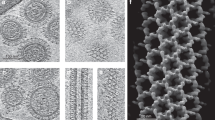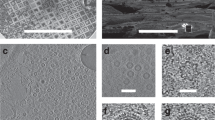Abstract
PBOBABLY the only macromolecules which have been observed directly are some of the larger proteins seen with the electron microscope. Although many polymers have a molecular size as great as these proteins, the width of the polymer chains is too small for them to be visible. The following observations on nucleic acid, however, suggest that these molocules can be seen individually.
This is a preview of subscription content, access via your institution
Access options
Subscribe to this journal
Receive 51 print issues and online access
$199.00 per year
only $3.90 per issue
Buy this article
- Purchase on Springer Link
- Instant access to full article PDF
Prices may be subject to local taxes which are calculated during checkout
Similar content being viewed by others
References
Oster, G., Trans. Farad. Soc., 46, 794 (1950).
Scott, J., Biochim. et Biophys. Acta, 2, 1 (1948).
Wilkins, M. H. F., Gosling, R. G., and Seeds, W. E., Nature, 167, 759 (1951).
Author information
Authors and Affiliations
Rights and permissions
About this article
Cite this article
BAYLEY, S. An Electron Microscope Study of Nucleic Acid. Nature 168, 470–471 (1951). https://doi.org/10.1038/168470a0
Issue Date:
DOI: https://doi.org/10.1038/168470a0
This article is cited by
-
The fine structure of the sea urchin spermatozoa as revealed by the electron microscope
Zeitschrift f�r Zellforschung und Mikroskopische Anatomie (1955)
-
Ver�nderungen des elektronenmikroskopischen Bildes von Kartoffel-X-Virus unter dem Einflu� verschiedener Chemikalien
Archiv f�r die gesamte Virusforschung (1954)
-
Elektronenmikroskopische Studien an Forellenspermatozoen und ihren Zellkernen
Chromosoma (1953)
-
Elektronenmikroskopische Aufnahmen von Kartoffel-X-Virus in gefriergetrocknetem Tabakrohsaft
Die Naturwissenschaften (1953)
Comments
By submitting a comment you agree to abide by our Terms and Community Guidelines. If you find something abusive or that does not comply with our terms or guidelines please flag it as inappropriate.



